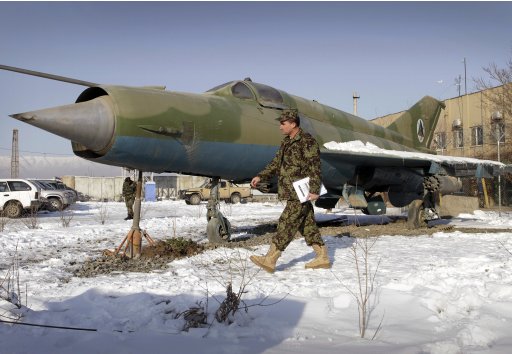M WAQAR..... "A man's ethical behavior should be based effectually on sympathy, education, and social ties; no religious basis is necessary.Man would indeed be in a poor way if he had to be restrained by fear of punishment and hope of reward after death." --Albert Einstein !!! NEWS,ARTICLES,EDITORIALS,MUSIC... Ze chi pe mayeen yum da agha pukhtunistan de.....(Liberal,Progressive,Secular World.)''Secularism is not against religion; it is the message of humanity.'' تل ده وی پثتونستآن
Wednesday, January 18, 2012
Afghan air force learns to fly _ and fix aircraft
Twenty years ago, Afghan Air Force pilot Maj. Abdul Aziz was streaking across the sky in the Soviet Union's deadliest fighter-bomber.
Now 45, his new task is less dramatic or flamboyant, yet perhaps even more important: Help build and train a new skilled air force that can keep the planes and helicopters in the air after Western mentors go home.
The challenge of forging a modern, technically proficient air force in a country at war is an immense but essential element in the West's exit strategy. The target date for having an Afghan Air Force able to operate fully independently, with about 8,000 trained personnel and 145 aircraft, is 2016.
The war against the resurgent Taliban has relied heavily on NATO aircraft to fly infantry units to remote outposts, keep them supplied in battle and provide close air support. Missiles fired from drones and exploding roadside bombs may get the media attention, but in a mountainous country with few paved roads, this has largely been a helicopter war.
Schooling a new cadre of pilots and air crews to fly is tough enough. But Lt. Gen. William Caldwell, who until last year headed NATO's training mission in Afghanistan, stressed that training the thousands of support and maintenance personnel is even more critical — if the force is to be sustainable in the long run.
If not, history will repeat itself. In the 1990s, the U.S.-backed Northern Alliance fighters battling the Taliban were flying Soviet-made helicopters left in Afghanistan after the Soviet withdrawal in 1989.
"The Northern Alliance chief of staff told me they had 70 helicopters, mostly Mil Mi-17s," Caldwell said. "Within a one-year period, none of them could fly anymore — not because they were shot out of the sky, but because the (Afghans) could not maintain and sustain them."
The NATO-led force is due to end its combat role in 2014, when it will hand over responsibility for security to the Afghan military and police. But thousands of troops and advisers will likely remain behind for at least several years to help train and mentor the government's security forces.
Allied nations have already supplied refurbished Italian-built C-27A tactical transports, Mi-35 helicopter gunships and Mi-17 transport choppers. Aside from the attack helicopters, the only dedicated close air support aircraft will be about two dozen A-29 Super Tucano counterinsurgency turboprops.
Afghanistan's air force dates to the 1920s, and reached its zenith during the 1980s Soviet occupation with nearly 500 fighter planes and bombers, transport aircraft and helicopter gunships. But it became little more than a scrap heap, left to decay by the Taliban during the civil war that followed the Soviet withdrawal, then destroyed on the ground by U.S. bombing in 2001.
So when the corps was reformed in 2005, it had to start from scratch. Thousands of different specialists — including crew chiefs, engine and airframe technicians, avionics and communications experts, loadmasters and air base firefighters — had to be recruited and trained. The force currently has about 5,000 members and 86 aircraft.
"I loved being a pilot, but I chose to become an instructor because I wanted to serve my country," said Maj. Aziz, whose exchanged the cockpit of a Sukhoi Su-22 fighter jet for a classroom. "I am training the trainers who will in the future be able to train all the personnel that the air force needs, without the help of foreign advisers and supervisors."
And the search for the right personnel became the major challenge in developing the service.
In contrast to the effort to reconstitute the Iraqi Air Force in the 1990s, which retained a large cadre of trained and experienced pilots and engineers from before the 2003 U.S. invasion, the task in Afghanistan is much more complicated because it requires that the air force be created from the ground up — including basics such as teaching recruits how to read and write.
"About 85 percent of our current recruits are illiterate — and that's on a good day," said Col. Michael T. Needham, commander of the 738th Air Expeditionary Advisory Squadron. The unit's American, Canadian, Jordanian and Portuguese instructors are assisting, training and advising the 230 Afghan staff of the aviation college at Kabul airport to provide general, as well as military, education.
"The goal is really to get them to a point where the mentors are not necessary," Needham said. "We would like to work ourselves out of the job."
A potentially equally serious problem is the air force's annual attrition rate of nearly 20 percent. While not as bad as the rate at which troops are leaving the desertion-ravaged Afghan Army, this makes it difficult to retain a cadre of trained and experienced personnel.
Pilots are being trained in Shindand in western Herat province. The school at Kabul airport is in charge of developing the maintenance skills that the ground crews will need to keep the planes flying.
In a sign of the difficulties faced by the air force in finding reliable personnel, an Afghan military pilot opened fire after an argument last April at Kabul airport, killing eight U.S. trainers and advisers and an American civilian contractor.
U.S. military investigators found no conclusive evidence that the officer, Col. Ahmed Gul, had any ties to the insurgency. But the incident illustrated the dangers faced by military and civilian trainers and advisers who work daily with Afghan forces to prepare for the eventual departure of international troops.
Subscribe to:
Post Comments (Atom)

No comments:
Post a Comment